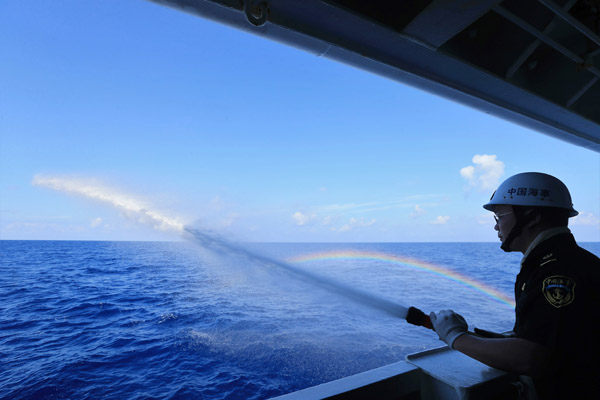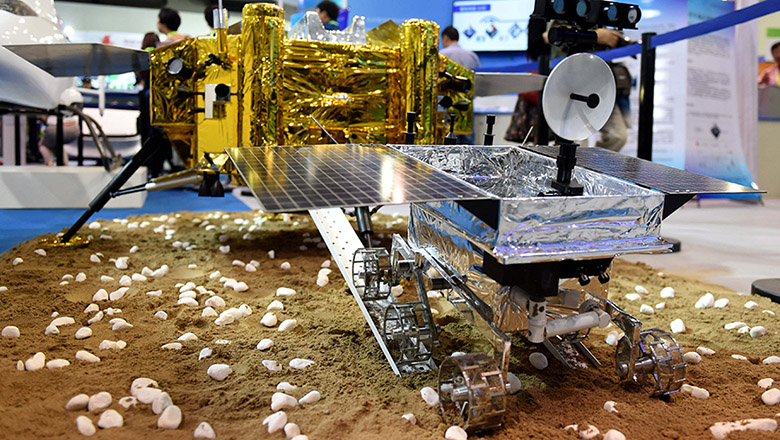China disputes US 'spy' flight claim
Updated: 2016-05-20 05:00
By ZHANG YUNBI in Beijing and CHEN WEIHUA in Washington(China Daily USA)
|
||||||||
Warns flights risk harm to security, bilateral ties
 |
|
A sailor is taking part in the fire drill on the Chinese patrol vessel "Haixun 01" on April 8, 2016 in the South China Sea. [Photo/Xinhua] |
China urged the United States on Thursday to "immediately stop close-in reconnaissance actions" after confirming that a US Navy EP-3 spy plane had conducted close-in flights near China's Hainan Island on Tuesday.
Such spy flights have led to serious clashes and hurt bilateral ties before, including the collision in 2001 between a Chinese PLA Navy J-8 fighter jet and a US Navy EP-3 spy plane off China's Hainan Island that caused the death of Chinese pilot Wang Wei.
The Pentagon said in a statement on Wednesday that two Chinese fighter jets conducted an "unsafe" intercept of a US military reconnaissance aircraft over the South China Sea on Tuesday, Reuters reported.
Peter Cook, the Pentagon press secretary, said on Thursday that the US side is reviewing the incident to see if there needs to be an appropriate response. He continued to describe the Chinese aircraft as operating in an unsafe manner.
Chinese Foreign Ministry spokesman Hong Lei said on Thursday, "We have information from the departments concerned, and what the US side has said is untrue."
As the US plane began close-in reconnaissance on Tuesday, two Chinese military airplanes "followed and monitored it in accordance with laws and regulations" and "maintained a safe distance" from it, Hong said. "China's operations subscribed to professional and security standards," he added.
"US military warships and aircraft have conducted close-in reconnaissance with high frequency for a long time, posing a serious threat to China's maritime and airspace security," Hong said.
White House Press Secretary Josh Earnest said on Thursday that the incident occurred in international airspace during a routine US patrol in the South China Sea.
Both Cook and Earnest emphasized that the confidence-building measures between the Chinese and US have helped reduce such incidents recently.
"We've reduced that risk by improving dialogue at multiple levels under the bilateral confidence-building measures, and the Military Maritime Consultative Agreement," Earnest said.
He said these are established diplomatic and military channels that allow the two sides to communicate clearly and raise concerns about these kinds of issues when they arise.
China and the US are expected to meet at the next military maritime consultative agreement talks in Hawaii on May 24-25, according to Earnest.
Observers said it is likely that Washington will continue its high-profile military presence in the South China Sea in the near future to maintain political pressure on China and bolster its overall regional strategy.
Zhang Junshe, a senior researcher at the PLA Naval Military Studies Research Institute, said the latest incident is part of US efforts to sustain tensions in the region, and it is only natural for Chinese forces to verify and identify US planes and warships that are approaching.
"But the US has preferred blaming its provoked targets before the targets publicly react, and the US aircraft pilots tend to impose belligerence," Zhang said. "Such spy flights are one of the root causes of danger."
Zhao Xiaozhuo, a researcher at the Center on China-America Defense Relations at the PLA Academy of Military Science, said it is not likely that security issues involving the two countries can be tackled quickly.
"The US' toughness militarily is backed by domestic public opinion and congressional voices," Zhao said.
- Russia to build first cruise liner in 60 years
- LinkedIn, Airbnb match refugees with jobs, disaster survivors with rooms
- Duterte 'willing to improve ties' with Beijing
- Canadian PM to introduce transgender rights bill
- Hillary Clinton says her husband not to serve in her cabinet
- New York cake show designs fool your eyes

 Striking photos around the world: May 16 - May 22
Striking photos around the world: May 16 - May 22
 Robots help elderly in nursing home in east China
Robots help elderly in nursing home in east China
 Hanging in the air: Chongqing holds rescue drill
Hanging in the air: Chongqing holds rescue drill
 2.1-ton tofu finishes in two hours in central China
2.1-ton tofu finishes in two hours in central China
 Six things you may not know about Grain Buds
Six things you may not know about Grain Buds
 China Beijing International High-tech Expo
China Beijing International High-tech Expo
 Highlights at Google I/O developers conference
Highlights at Google I/O developers conference
 Nation celebrates International Museum Day
Nation celebrates International Museum Day
Most Viewed
Editor's Picks

|

|

|

|

|

|
Today's Top News
Liang avoids jail in shooting death
China's finance minister addresses ratings downgrade
Duke alumni visit Chinese Embassy
Marriott unlikely to top Anbang offer for Starwood: Observers
Chinese biopharma debuts on Nasdaq
What ends Jeb Bush's White House hopes
Investigation for Nicolas's campaign
Will US-ASEAN meeting be good for region?
US Weekly

|

|







